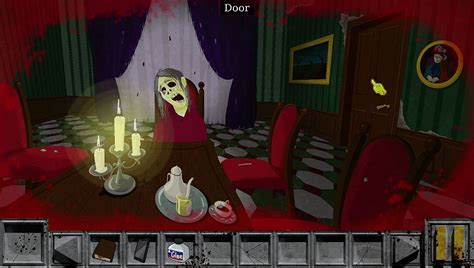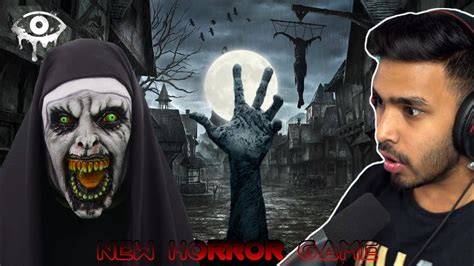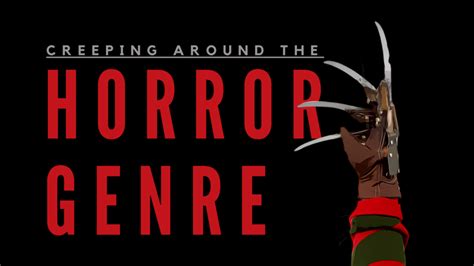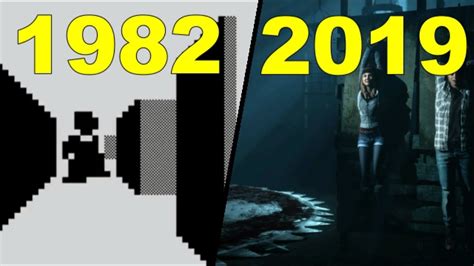Breaking News


Popular News


Explore the evolution of horror games from their early roots to the emergence of virtual reality, tracing the impact of technology, storytelling, and psychological elements.Horror games have been a popular and spine-tingling genre in the world of gaming for decades. From the early text-based adventures to the immersive and terrifying virtual reality experiences of today, the evolution of horror games has been a fascinating journey. In this blog post, we will explore the history and progression of horror games, from their early roots to the introduction of survival horror and psychological elements, all the way to the emergence of virtual reality horror games. We will also take a closer look at the influence of technology on the development of horror games and how storytelling in this genre has evolved over the years. Whether you’re a die-hard horror game fan or simply curious about the evolution of gaming, join us as we delve into the spine-chilling world of horror games.

The early roots of horror gaming can be traced back to the late 1970s and early 1980s with the release of text-based adventure games such as Hunt the Wumpus and Mystery House. These games relied on the player’s imagination to create a sense of fear and suspense, as the limited graphics and technology at the time could not provide the same visual scares we see in modern horror games.
As technology advanced, the horror gaming genre began to incorporate more visual elements, giving birth to classics like Alone in the Dark and Resident Evil. These games were among the first to use 3D graphics and cinematic camera angles to create a more immersive and terrifying experience for players.
Additionally, the rise of personal computers and gaming consoles allowed horror games to reach a wider audience, leading to the development of iconic titles like Silent Hill and Fatal Frame. These games pushed the boundaries of horror storytelling and gameplay, setting the stage for the evolution of the genre in the years to come.

Technology has played a significant role in the evolution of horror games. From the early days of pixelated graphics and limited sound capabilities, to the realistic 3D environments and immersive audio experiences of today, advancements in technology have greatly enhanced the overall horror gaming experience.
The introduction of high-definition graphics and advanced lighting effects has allowed developers to create visually stunning and atmospheric game worlds that can instill a greater sense of fear and dread in players. The use of motion capture technology has also improved the realism of character animations, making the on-screen horrors feel more lifelike and terrifying.
Furthermore, the integration of virtual reality (VR) technology has revolutionized the horror gaming genre, allowing players to immerse themselves in truly immersive and terrifying experiences. VR headsets and motion controllers enable players to interact with the game world in a more visceral and intimate way, heightening the sense of fear and anxiety.
As technology continues to advance, the potential for horror games to deliver even more terrifying and atmospheric experiences is limitless. With the advent of more powerful hardware and innovative software development techniques, the future of horror gaming looks incredibly promising, with even more realistic and bone-chilling experiences on the horizon.

The introduction of survival horror genre in video games marked a significant shift in the gaming industry. It was in the early 1990s when the term ‘survival horror’ was first coined, and games like Resident Evil and Silent Hill were at the forefront of this new genre. These games focused on creating a sense of fear and tension by limiting the player’s resources and placing them in environments filled with horrifying creatures and obstacles. The emphasis was not merely on combat, but on the survival aspect as players navigated through the game world.
The survival horror genre revolutionized the gaming experience by incorporating elements of fear, suspense, and exploration. It introduced a new level of immersion, forcing players to think strategically and conserve their resources to progress in the game. The introduction of this genre also paved the way for the popularity of psychological horror elements, such as jump scares, eerie sound effects, and unsettling visual imagery.
One notable feature of survival horror games was the emphasis on puzzle-solving and backtracking, which added another layer of challenge and engagement for players. The overall atmosphere of these games was designed to evoke a feeling of dread and unease, setting them apart from traditional action-oriented titles. The success and impact of the survival horror genre led to the development of numerous iconic franchises that continue to influence the gaming landscape today.
| Notable Survival Horror Games |
|---|
| Resident Evil |
| Silent Hill |
| Alone in the Dark |
| Amnesia: The Dark Descent |

The Evolution of Horror Games: A Brief History
Impact of psychological horror elements
Psychological horror elements have played a significant role in the evolution of horror games. These elements focus on creating an unsettling and eerie atmosphere, often emphasizing the psychological aspects of fear rather than relying on jump scares or graphic violence. The use of sound design is a key component in psychological horror, as it can instill a sense of unease and tension in players. Additionally, the narrative in psychological horror games often delves into complex and disturbing themes, challenging players to confront their own fears and anxieties.
Furthermore, the incorporation of environmental storytelling in horror games has contributed to the impact of psychological horror elements. Through carefully crafted level design and immersive world-building, players are immersed in environments that evoke a sense of dread and foreboding. The use of symbolism and subtle visual cues can elicit a deep sense of unease, heightening the psychological impact of the game.
In recent years, the advancement of virtual reality technology has further enhanced the impact of psychological horror elements in gaming. The immersive nature of VR allows players to be fully enveloped in the eerie atmosphere of psychological horror games, heightening the sense of fear and discomfort. The use of spatial audio in VR also amplifies the psychological impact, as players are fully immersed in the haunting sounds of the game world.
| Impact of Psychological Horror Elements |
|---|
| Emphasis on psychological aspects of fear |
| Use of sound design and narrative |
| Incorporation of environmental storytelling |
| Advancement of virtual reality technology |

Storytelling in horror games has undergone a significant evolution over the years, with developers constantly pushing the boundaries to create more immersive and engaging experiences for players. Early horror games relied heavily on atmospheric storytelling, using eerie environments and minimal dialogue to set the tone for the game. As technology advanced, developers began to incorporate more intricate narratives into their games, crafting compelling storylines that kept players on the edge of their seats.
With the influence of technology on horror games, developers were able to create more complex and lifelike characters, as well as dynamic environments that reacted to the player’s actions. This allowed for a more nuanced approach to storytelling, as players were able to interact with the game world in ways that were previously impossible. The introduction of survival horror games in the 1990s further revolutionized storytelling in the genre, placing a greater emphasis on resource management and decision-making, which in turn impacted the narrative of the games.
The impact of psychological horror elements cannot be understated when discussing the evolution of horror game storytelling. Games began to delve deeper into the psyche of the protagonist, introducing elements of psychological horror that played on the player’s fears and anxieties. This further heightened the immersive nature of storytelling in horror games, as players found themselves drawn into the intricate web of the game’s narrative.
As we move into the future, the emergence of virtual reality has once again challenged developers to innovate in their storytelling. VR horror games offer a level of immersion and interaction that was previously unimaginable, allowing for even more intense and engaging narratives that play on the player’s senses in new and thrilling ways.

The emergence of virtual reality technology has brought about a revolution in the gaming industry, especially in the horror genre. With the ability to immerse players in a fully interactive and realistic environment, virtual reality has opened up new possibilities for horror game development. Developers are now able to create incredibly intense and terrifying experiences that play on the player’s deepest fears and phobias, truly bringing the horror genre to life in a way that was never before possible.
One of the key advantages of virtual reality in horror games is the heightened sense of presence and immersion that it offers. Unlike traditional gaming, where players are merely looking at a screen, virtual reality allows them to feel as though they are actually inside the game world. This creates a much more intense and visceral experience, with players feeling as though they are truly in danger and facing the horrors within the game.
Additionally, virtual reality horror games have the potential to tap into a whole new level of psychological horror. By manipulating the player’s senses and perception of reality, developers can create truly terrifying experiences that reach deep into the player’s subconscious. This has the potential to elicit intense emotional responses and create lasting psychological impact, making virtual reality horror games some of the most terrifying and immersive experiences in gaming.
| Virtual Reality Horror Games | Release Date |
|---|---|
| Resident Evil 7: Biohazard | 2017 |
| Until Dawn: Rush of Blood | 2016 |
| VR Paranormal Activity: The Lost Soul | 2017 |
| The Exorcist: Legion VR | 2018 |
The popularity of virtual reality horror games continues to grow, with more and more developers exploring the potential of this new technology. As virtual reality hardware becomes more accessible and affordable, we can expect to see an even greater proliferation of terrifying and immersive experiences. Whether it’s facing the horrors of a haunted mansion or being pursued by grotesque monsters, virtual reality horror games are poised to continue pushing the boundaries of fear and terror in gaming.

What is the first horror game ever created?
The first horror game ever created is generally considered to be Haunted House, released in 1982 for the Atari 2600.
How have horror games evolved over the years?
Horror games have evolved from simple 2D graphics to more immersive 3D environments, with improved storytelling, graphics, and sound effects, creating more realistic and terrifying experiences for players.
What are some iconic horror games that have made a significant impact?
Games like Resident Evil, Silent Hill, and Amnesia: The Dark Descent are often cited as iconic horror games that have made a significant impact on the genre.
What are some common elements found in horror games?
Common elements found in horror games include dark and creepy environments, jump scares, puzzles, survival aspects, and a sense of vulnerability for the player character.
How has virtual reality (VR) technology influenced horror games?
Virtual reality technology has significantly enhanced the immersive experience of horror games, allowing players to feel as if they are truly in the terrifying environments, increasing the intensity and fear factor.
What are some upcoming horror games to look out for?
Upcoming horror games to look out for include titles like Resident Evil Village, The Medium, and Little Nightmares II, which promise to offer new and terrifying experiences for players.
What is the appeal of horror games for players?
The appeal of horror games for players often lies in the adrenaline rush, the suspenseful atmosphere, the sense of accomplishment in overcoming fear, and the thrill of facing terrifying challenges within a game environment.